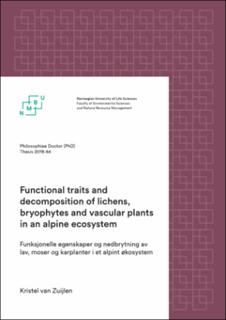| dc.description.abstract | Functional traits influence how an organism responds to its environment and how this can affect ecosystem processes such as decomposition. The majority of trait-based studies have focused on vascular plants, while non-vascular primary producers such as lichens and bryophytes are underrepresented in the trait literature. This is despite their large contribution to aboveground biomass and species richness in high latitude and high elevation ecosystems, and prevalent role in ecosystem processes such as decomposition and nutrient cycling. The objective for this thesis was to study functional traits of three different primary producer groups, i.e. vascular plants, lichens and bryophytes, and identify how these groups and their traits affect decomposition in an alpine ecosystem. This was done using an elevational gradient and a lichen transplant experiment in Finse, southern Norway. Across the elevational gradient, we measured community-level functional traits of vascular plants, lichens and bryophytes (Paper I), decomposability of lichens and bryophytes (Paper III) and secondary compounds of vascular plants and lichens (Paper IV). In addition, we assessed the relative importance of species turnover and intraspecific variation on these responses. In the lichen transplant experiment, we studied the effects of different mat-forming lichens on microclimate and decomposition of plant litter (Paper II).
Temperature (and corresponding growing season length) is assumed the main environmental variable that changes across the elevational gradient, but there are other factors that also change, such as precipitation, available nutrients, and herbivory. These additional factors might also have played a role in the observed responses of vascular plants, lichens and bryophytes across elevation. We found that lichens had higher intraspecific variation than vascular plants and bryophytes for N concentration and N:P ratio, inplying a great deal of intraspecific plasticity (Paper I). In general, the drivers of community-level functional traits differed among traits as well as primary producer groups. Some traits, e.g. increase in N concentration indicated a shift to increasing resource acquisition with elevation, which is opposite of what we expected. In line with increasing N at higher elevation, community-level decomposability of lichens and bryophytes increased, which was mainly driven by species turnover (Paper III). Decomposability, both at the community-level and across the entire dataset, was explained by tissue pH, primary producer group (lichens vs bryophytes) and nutrient concentration. Vascular plant secondary compounds decreased while lichen secondary compounds increased with elevation (Paper IV). Variability in lichen cortical compounds were for a large part driven by intraspecific variation. Furthermore, plant secondary compounds shifted from those associated with herbivore defence towards those protecting against light and oxidative stress as elevation increased. Mat-forming lichens reduced the mean soil temperature and the number of soil freeze-thaw cycles, and Cladonia rangiferina/stygia insulated better than other lichens, as a result of its high water holding capacity (Paper II). Decomposition of plant litter was faster under Nephromopsis nivalis than under Alectoria ochroleuca, but this was not related to microclimate or functional traits.
Our findings highlight that vascular plants, lichens and bryophytes may respond differently to the same environmental gradient, which has implications for ecosystem processes. Intraspecific variation contributed substantially to functional traits and was especially important for lichen traits and lichen secondary compounds. High intraspecific plasticity implies that lichen species might be more resilient to environmental changes than vascular plant and bryophyte species. However, high intraspecific variation may not necessarily be important for ecosystem processes such as decomposition, as species turnover was the main driver of variation in decomposability of lichens and bryophytes. Further, as mat-forming lichens can affect decomposition of other litter types, this could affect carbon and nutrient dynamics of mixed plant and lichen communities on a larger scale. Finally, future climate warming may result in a shift towards slower decomposable species, which might counterbalance the increased microbial respiration under higher temperatures. | en_US |

